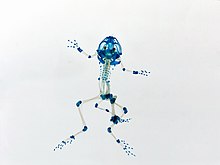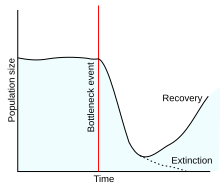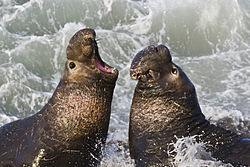The Golden toad of Monteverde, Costa Rica, was among the first casualties of amphibian declines. Formerly abundant, it was last seen in 1989.
The decline in amphibian populations is an ongoing mass extinction of amphibian species worldwide. Since the 1980s, decreases in amphibian populations, including population crashes and mass localized extinctions, have been observed in locations all over the world. These declines are known as one of the most critical threats to global biodiversity, and several causes are believed to be involved, including disease, habitat destruction and modification, exploitation, pollution, pesticide use, introduced species, and ultraviolet-B
radiation (UV-B). However, many of the causes of amphibian declines are
still poorly understood, and the topic is currently a subject of much
ongoing research. Calculations based on extinction rates suggest that
the current extinction rate of amphibians could be 211 times greater
than the background extinction rate and the estimate goes up to 25,000–45,000 times if endangered species are also included in the computation.
Although scientists began observing reduced populations of
several European amphibian species already in the 1950s, awareness of
the phenomenon as a global problem and its subsequent classification as a
modern-day mass extinction only dates from the 1980s. By 1993, more
than 500 species of frogs and salamanders present on all five continents
were in decline. Today, the phenomenon of declining amphibian
populations affects thousands of species in all types of ecosystems and
is thus recognized as one of the most severe examples of the Holocene extinction, with severe implications for global biodiversity.
Background
In the past three decades, declines in populations of amphibians (the class of organisms that includes frogs, toads, salamanders, newts, and caecilians)
have occurred worldwide. In 2004, the results were published of the
first worldwide assessment of amphibian populations, the Global
Amphibian Assessment. This found that 32% of species were globally
threatened, at least 43% were experiencing some form of population
decrease, and that between 9 and 122 species have become extinct since
1980. As of 2010, the IUCN Red List, which incorporates the Global Amphibian Assessment and subsequent updates, lists 486 amphibian species as "Critically Endangered".
Despite the high risk this group faces, recent evidence suggests the
public is growing largely indifferent to this and other environmental
problems, posing serious problems for conservationists and environmental
workers alike.
Habitat loss, disease and climate change are thought to be responsible for the drastic decline in populations in recent years.
Declines have been particularly intense in the western United States, Central America, South America, eastern Australia and Fiji
(although cases of amphibian extinctions have appeared worldwide).
While human activities are causing a loss of much of the world's
biodiversity, amphibians appear to be suffering much greater effects
than other classes of organism. Because amphibians generally have a
two-staged life cycle consisting of both aquatic (larvae) and terrestrial (adult) phases, they are sensitive to both terrestrial and aquatic environmental effects. Because their skins are highly permeable, they may be more susceptible to toxins in the environment than other organisms such as birds or mammals. Many scientists believe that amphibians serve as "canaries in a coal mine," and that declines in amphibian populations and species indicate that other groups of animals and plants will soon be at risk.
Declines in amphibian populations were first widely recognized in the late 1980s, when a large gathering of herpetologists reported noticing declines in populations in amphibians across the globe. Among these species, the Golden toad (Bufo periglenes) endemic to Monteverde, Costa Rica,
featured prominently. It was the subject of scientific research until
populations suddenly crashed in 1987 and it had disappeared completely
by 1989. Other species at Monteverde, including the Monteverde Harlequin Frog (Atelopus varius),
also disappeared at the same time. Because these species were located
in the pristine Monteverde Cloud Forest Reserve, and these extinctions
could not be related to local human activities, they raised particular
concern among biologists.
Initial skepticism
When
amphibian declines were first presented as a conservation issue in the
late 1980s, some scientists remained unconvinced of the reality and
gravity of the conservation issue.
Some biologists argued that populations of most organisms, amphibians
included, naturally vary through time. They argued that the lack of
long-term data on amphibian populations made it difficult to determine
whether the anecdotal declines reported by biologists were worth the
(often limited) time and money of conservation efforts.
However, since this initial skepticism, biologists have come to a
consensus that declines in amphibian populations are a real and severe
threat to biodiversity.
This consensus emerged with an increase in the number of studies that
monitored amphibian populations, direct observation of mass mortality in
pristine sites that lacked apparent cause, and an awareness that
declines in amphibian populations are truly global in nature.
Potential causes
Numerous
potential explanations for amphibian declines have been proposed. Most
or all of these causes have been associated with some population
declines, so each cause is likely to affect in certain circumstances but
not others. Many of the causes of amphibian declines are well
understood, and appear to affect other groups of organisms as well as
amphibians. These causes include habitat modification and
fragmentation, introduced predators or competitors, introduced species,
pollution, pesticide use, or over-harvesting. However, many amphibian
declines or extinctions have occurred in pristine habitats where the
above effects are not likely to occur. The causes of these declines are
complex, but many can be attributed to emerging diseases, climate
change, increased ultraviolet-B radiation, or long-distance transmission
of chemical contaminants by wind.
Artificial lighting has been suggested as another potential
cause. Insects are attracted to lights making them scarcer within the
amphibian habitats.
Habitat modification
Habitat
modification or destruction is one of the most dramatic issues
affecting amphibian species worldwide. As amphibians generally need
aquatic and terrestrial habitats to survive, threats to either habitat
can affect populations. Hence, amphibians may be more vulnerable to
habitat modification than organisms that only require one habitat type.
Large scale climate changes may further be modifying aquatic habitats,
preventing amphibians from spawning altogether.
Habitat fragmentation
Habitat fragmentation occurs when habitats are isolated by habitat
modification, such as when a small area of forest is completely
surrounded by agricultural fields. Small populations that survive
within such fragments are often susceptible to inbreeding, genetic drift, or extinction due to small fluctuations in the environment.
Pollution and chemical contaminants
There is evidence of chemical pollutants causing frog developmental deformities (extra limbs, or malformed eyes). Pollutants have varying effects on frogs. Some alter the central nervous system; others like atrazine
cause a disruption in the production and secretion of hormones.
Experimental studies have also shown that exposure to commonly used
herbicides such as glyphosate (Tradename Roundup) or insecticides such as malathion or carbaryl greatly increase mortality of tadpoles.
Additional studies have indicated that terrestrial adult stages of
amphibians are also susceptible to non-active ingredients in Roundup,
particularly POEA, which is a surfactant.
Atrazine has been shown to cause male tadpoles of African clawed frogs
to become hermaphroditic with development of both male and female
organs. Such feminization has been reported in many parts of the world.
In a study conducted in a laboratory at Uppsala University in Sweden,
more than 50% of frogs exposed to levels of estrogen-like pollutants
existing in natural bodies of water in Europe and the United States
became females. Tadpoles exposed even to the weakest concentration of
estrogen were twice as likely to become females while almost all of the
control group given the heaviest dose became female.
While most pesticide effects are likely to be local and restricted to areas near agriculture, there is evidence from the Sierra Nevada mountains of the western United States that pesticides are traveling long distances into pristine areas, including Yosemite National Park in California.
Some recent evidence points to ozone as a possible contributing factor to the worldwide decline of amphibians.
Ozone depletion, ultraviolet radiation and cloud cover
Like many other organisms, increasing ultraviolet-B (UVB) radiation due to stratospheric ozone depletion and other factors may harm the DNA of amphibians, particularly their eggs.
The amount of damage depends upon the life stage, the species type and
other environmental parameters. Salamanders and frogs that produce less photolyase,
an enzyme that counteracts DNA damage from UVB, are more susceptible to
the effects of loss of the ozone layer. Exposure to ultraviolet
radiation may not kill a particular species or life stage but may cause
sublethal damage.
More than three dozen species of amphibians have been studied,
with severe effects reported in more than 40 publications in
peer-reviewed journals representing authors from North America, Europe
and Australia. Experimental enclosure approaches to determine UVB
effects on egg stages have been criticized; for example, egg masses were
placed at water depths much shallower than is typical for natural
oviposition sites. While UVB radiation is an important stressor for
amphibians, its effect on the egg stage may have been overstated.
Anthropogenic climate change has likely exerted a major effect on
amphibian declines. For example, in the Monteverde Cloud Forest, a
series of unusually warm years led to the mass disappearances of the
Monteverde Harlequin frog and the Golden Toad. An increased level of cloud cover, a result of geoengineering
and global warming, which has warmed the nights and cooled daytime
temperatures, has been blamed for facilitating the growth and
proliferation of the fungus Batrachochytrium dendrobatidis (the causative agent of the fungal infection chytridiomycosis).
An adult male Ecnomiohyla rabborum in the Atlanta Botanical Garden, a species ravaged by Batrachochytrium dendrobatidis
in its native habitat. It was the last known surviving member of its
species, and with its death on Sept 28, 2016, the species is believed to
be extinct.
Although the immediate cause of the die offs was the chytrid, climate
change played a pivotal role in the extinctions. Researchers included
this subtle connection in their inclusive climate-linked epidemic
hypothesis, which acknowledged climatic change as a key factor in
amphibian extinctions both in Costa Rica and elsewhere.
New evidence has shown global warming to also be capable of directly degrading toads' body condition and survivorship.
Additionally, the phenomenon often colludes with landscape
alteration, pollution, and species invasions to effect amphibian
extinctions.
Disease
A number of diseases have been related to mass die-offs or declines in populations of amphibians, including "red-leg" disease (Aeromonas hydrophila), Ranavirus (family Iridoviridae), Anuraperkinsus, and chytridiomycosis.
It is not entirely clear why these diseases have suddenly begun to
affect amphibian populations, but some evidence suggests that these
diseases may have been spread by humans, or may be more virulent when
combined with other environmental factors.
Trematodes
Trematode cyst-infected Pacific Tree Frog (Hyla regilla)
with supernumerary limbs, from La Pine, Deschutes County, Oregon,
1998-9. This 'category I' deformity (polymelia) is believed to be caused
by the trematode cyst infection. The cartilage is stained blue and
calcified bones in red.
There is considerable evidence that parasitic trematode platyhelminths (a type of fluke) have contributed to developmental abnormalities and population declines of amphibians in some regions. These trematodes of the genus Ribeiroia
have a complex life cycle with three host species. The first host
includes a number of species of aquatic snails. The early larval stages
of the trematodes then are transmitted into aquatic tadpoles, where the
metacercariae (larvae) encyst in developing limb buds. These encysted
life stages produce developmental abnormalities in post-metamorphic
frogs, including additional or missing limbs. These abnormalities increase frog predation by aquatic birds, the final host of the trematode.
Pacific Tree Frog with limb malformation induced by Ribeiroia ondatrae
A study showed that high levels of nutrients used in farming and
ranching activities fuel parasite infections that have caused frog
deformities in ponds and lakes across North America. The study showed
increased levels of nitrogen and phosphorus cause sharp hikes in the
abundance of trematodes, and that the parasites subsequently form cysts
in the developing limbs of tadpoles causing missing limbs, extra limbs
and other severe malformations including five or six extra or even no
limbs.
Chytridiomycosis
A chytrid-infected frog
In 1998, following large-scale frog deaths in Australia and Central
America, research teams in both areas came up with identical results: a
previously undescribed species of pathogenic fungus, Batrachochytrium dendrobatidis. It is now clear that many recent extinctions of amphibians in Australia and the Americas are linked to this fungus. This fungus belongs to a family of saprobes known as chytrids that are not generally pathogenic.
The disease caused by Batrachochytrium dendrobatidis is called chytridiomycosis. Frogs infected by this disease generally show skin lesions and hyperkeratosis,
and it is believed that death occurs because of interference with skin
functions including maintenance of fluid balance, electrolyte homeostasis, respiration and role as a barrier to infections. The time from infection to death has been found to be 1–2 weeks in experimental tests, but infected animals can carry the fungus as long as 220 days. There are several hypotheses on the transmission and vectors of the fungus.
Subsequent research has established that the fungus has been
present in Australia since at least 1978, and present in North America
since at least the 1970s. The first known record of chytrid infection
in frogs is in the African Clawed Frog, Xenopus laevis.
Because Xenopus are sold in pet shops and used in laboratories
around the world, it is possible that the chytrid fungus may have been
exported from Africa.
Introduced predators
Non-native predators and competitors have also been found to affect the viability of frogs in their habitats. The mountain yellow-legged frog which typically inhabits the Sierra Nevada lakes have seen a decline in numbers due to stocking of non-native fish (trout) for recreational fishing. The developing tadpoles and froglets fall prey to the fish in large numbers. This interference in the frog's three-year metamorphosis is causing a decline that is manifest throughout their ecosystem.
Increased noise levels
Frogs
and toads are highly vocal, and their reproductive behaviour often
involves the use of vocalizations. There have been suggestions that
increased noise levels caused by human activities may be contributing to
their declines. In a study in Thailand, increased ambient noise levels were shown to decrease calling in some species and to cause an increase in others. This has, however, not been shown to be a cause for the widespread decline.
Symptoms of stressed populations
Amphibian
populations in the beginning stages of decline often exude a number of
signs, which may potentially be used to identify at-risk segments in
conservation efforts. One such sign is developmental instability, which
has been proven as evidence of environmental stress.
This environmental stress can potentially raise susceptibility to
diseases such as chytridiomycosis, and thus lead to amphibian declines.
In a study conducted in Queensland, Australia, for example, populations of two amphibian species, Litoria nannotis and Litoria genimaculata,
were found to exhibit far greater levels of limb asymmetry in
pre-decline years than in control years, the latter of which preceded
die offs by an average of 16 years.
Learning to identify such signals in the critical period before
population declines occur might greatly improve conservation efforts.
Conservation measures
The first response to reports of declining amphibian populations was
the formation of the Declining Amphibian Population Task Force (DAPTF)
in 1990. DAPFT led efforts for increased amphibian population monitoring
in order to establish the extent of the problem, and established
working groups to look at different issues. Results were communicated through the newsletter Froglog.
Much of this research went into the production of the first
Global Amphibian Assessment (GAA), which was published in 2004 and
assessed every known amphibian species against the IUCN Red List
criteria. This found that approximately one third of amphibian species
were threatened with extinction.
As a result of these shocking findings an Amphibian Conservation Summit
was held in 2005, because it was considered "morally irresponsible to
document amphibian declines and extinctions without also designing and
promoting a response to this global crisis".
Outputs from the Amphibian Conservation Summit included the first Amphibian Conservation Action Plan (ACAP) and to merge the DAPTF and the Global Amphibian Specialist Group into the IUCN SSC Amphibian Specialist Group (ASG).
The ACAP established the elements required to respond to the crisis,
including priority actions on a variety of thematic areas. The ASG is a
global volunteer network of dedicated experts who work to provide the
scientific foundation for effective amphibian conservation action around
the world.
On 16 February 2007, scientists worldwide met in Atlanta, U.S., to form a group called the Amphibian Ark to help save more than 6,000 species of amphibians from disappearing by starting captive breeding programmes.
Areas with noticed frog extinctions, like Australia, have few
policies that have been created to prevent the extinction of these
species. However, local initiatives have been placed where conscious
efforts to decrease global warming will also turn into a conscious
effort towards saving the frogs. In South America, where there is also
an increased decline of amphibian populations, there is no set policy to
try to save frogs. Some suggestions would include getting entire
governments to place a set of rules and institutions as a source of
guidelines that local governments have to abide by.
A critical issue is how to design protected areas for amphibians
which will provide suitable conditions for their survival. Conservation
efforts through the use of protected areas have shown to generally be a
temporary solution to population decline and extinction because the
amphibians become inbred. It is crucial for most amphibians to maintain a high level of genetic variation through large and more diverse environments.
Education of local people to protect amphibians is crucial, along
with legislation for local protection and limiting the use of toxic
chemicals, including some fertilizers and pesticides in sensitive
amphibian areas.











